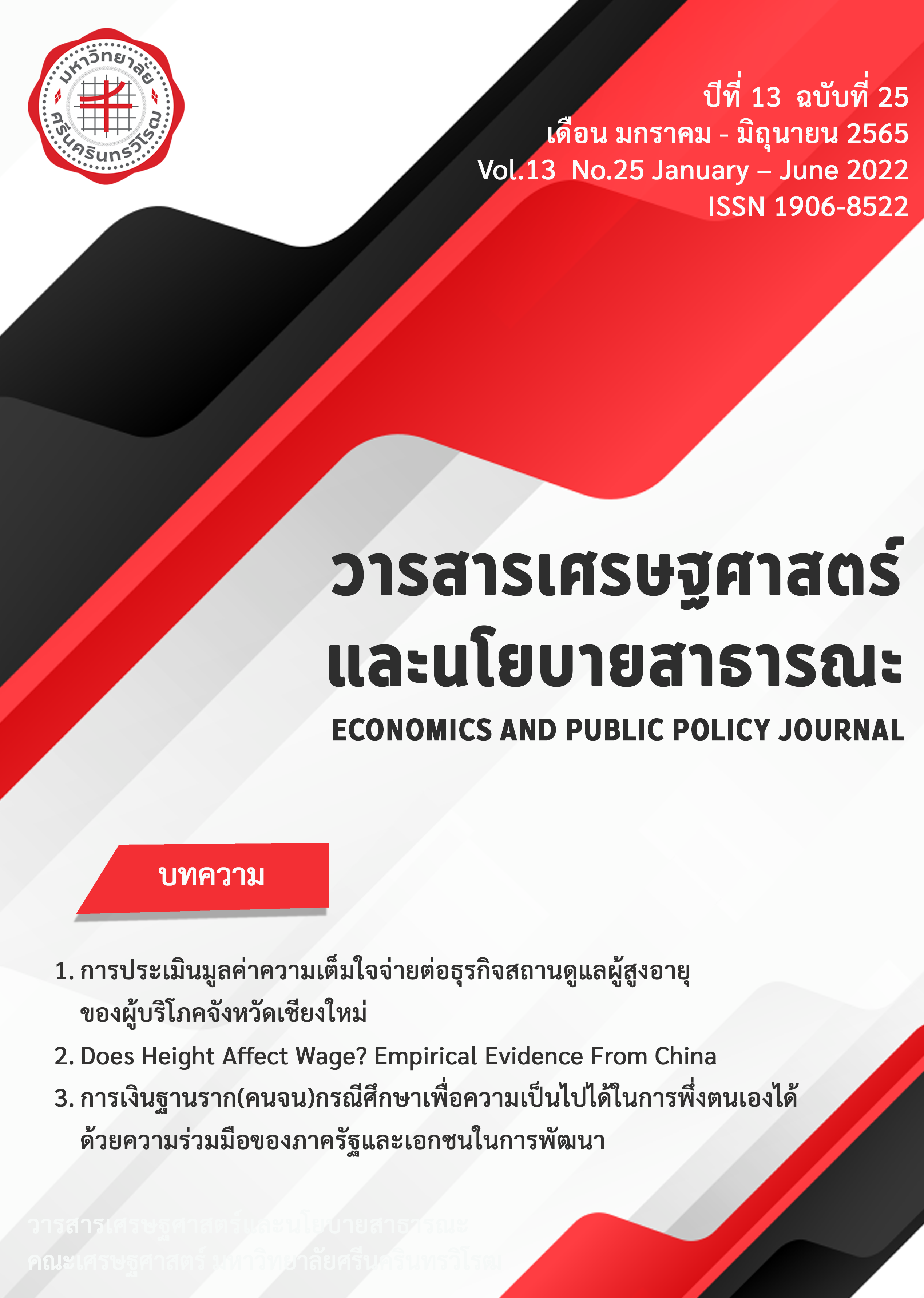Does Height Affect Wage? Empirical Evidence From China
Main Article Content
บทคัดย่อ
Research shows that: Firstly, height has a significant positive effect on income. It means there is a phenomenon of height discrimination in the Chinese labor market. Secondly, height discrimination has obvious regional heterogeneity, but the impact of each region on men and women. The degree of discrimination cannot be explained here because the level of discrimination in the eastern region is lower than in economically underdeveloped regions because the central, western, and eastern regions have different levels of high discrimination and no regularity. Fourthly, height discrimination is likely to come from employer discrimination in the labor market, because there is obvious height discrimination in certain types of businesses and industries, especially service industries. This does not indicate that when solving the discrimination problem in the labor market. It is not important to increase its own human capital. The increase in the level of personal human capital makes it obtain a position with a higher professional reputation and an increase in the human capital stock of the labor force. It is crucial to the long-term economic development of a country or region. In terms of policies, the adoption of relevant legislation to regulate the labor market and ensure equal pay for equal work and equal employment opportunities have a positive significance in eliminating differences in the appearance of the labor market. Periodic nutrition and sanitation environmental interventions also play an important role in the return from the labor market throughout the life cycle.
Article Details

อนุญาตภายใต้เงื่อนไข Creative Commons Attribution-NonCommercial-NoDerivatives 4.0 International License.
สงวนลิขสิทธิ์ © 2553 คณะเศรษฐศาสตร์ มหาวิทยาลัยศรีนครินทรวิโรฒ
คณะเศรษฐศาสตร์ มหาวิทยาลัยศรีนครินทรวิโรฒ จัดพิมพ์วารสารเศรษฐศาสตร์และนโยบายสาธารณะ เพื่อเผยแพร่บทความวิชาการทางเศรษฐศาสตร์ นโยบายสารธารณะ และสาขาอื่นๆที่เกี่ยวข้อง ทัศนะและข้อคิดเห็นใดๆ ที่ปรากฏในวารสารเป็นความคิดเห็นส่วนตัวของผู้เขียน โดยบทความที่ได้รับการตอบรับจะถือเป็นลิขสิทธิ์ของคณะเศรษฐศาสตร์ มหาวิทยาลัยศรีนครินทรวิโรฒ
บรรณาธิการ อาจารย์ ดร.พลพัธน์ โคตรจรัส
เอกสารอ้างอิง
Case, A., & Paxson, C. (2008). Stature and status: Height, ability, and labor market outcomes. Journal of political Economy, 116(3), 499-532.
Chai, G. (2011). Gender Wage Gaps and Discrimination for College Graduates during the Market-Oriented Reform [J]. South China Journal of Economics, 3.
Gao Wenshu. (2009). Health human capital investment, height and wage compensation. Chinese Population Science, 3, 76-86.
Hamermesh, D. S., & Biddle, J. E. (1993). Beauty and the labor market (No. w4518). National Bureau of Economic Research.
Heckman, J. J., Lochner, L. J., & Todd, P. E. (2003). Fifty years of Mincer earnings regressions (No. w9732). National Bureau of Economic Research.
Heineck, G. (2005). Up in the skies? The relationship between body height and earnings in Germany. Labour, 19(3), 469-489.
Hensley, W. E., & Cooper, R. (1987). Height and occupational success: a review and critique. Psychological Reports, 60(3), 843-849.
Hübler, O. (2006). The nonlinear link between height and wages: an empirical investigation.
Hur, Y. M., & Shin, J. S. (2008). Effects of chorion type on genetic and environmental influences on height, weight, and body mass index in South Korean young twins. Twin Research and Human Genetics, 11(1), 63-69.
Judge, T. A., & Cable, D. M. (2004). The effect of physical height on workplace success and wage: preliminary test of a theoretical model. Journal of Applied Psychology, 89(3), 428.
Lundborg, P., Nystedt, P., & Rooth, D. O. (2010). No country for fat men? Obesity, earnings, skills, and health among 450,000 Swedish men.
Persico, N., Postlewaite, A., & Silverman, D. (2004). The effect of adolescent experience on labor market outcomes: The case of height. Journal of Political Economy, 112(5), 1019-1053.
Schick, A., & Steckel, R. H. (2010). Height as a proxy for cognitive and non-cognitive ability (No. w16570). National Bureau of Economic Research.
Schultz, T. P. (2002). Wage gains associated with height as a form of health human capital. American Economic Review, 92(2), 349-353.
Sohn, K. (2013). Monetary and Nonmonetary Returns to Education in I ndonesia. The Developing Economies, 51(1), 34-59.
Sohn, K. (2015). The height premium in Indonesia. Economics & Human Biology, 16, 1-15.
Wenshu, G. (2009). Health Human Capital Investment, Height and Wages: An Empirical Study Using Household Survey Data from 12 Chinese Cities [J]. Chinese Journal of Population Science, 3.
ZHANG, Q. J. K. (2013). “Economics of Beauty" in China's Labor Market: Does Stature Matter?. China Economic Quarterly, (3), 12.
ZHANG, K., TAO, D., & JIANG, Q. (2013). Sibling Competition and Education Attainment: Evidence from Rural China. Education & Economy, (6), 7.
Zhang Xiaoyun, Xin Binghai, & Du Liqun. (2018). Can marketization eliminate discrimination? Evidence from "height premium". Financial Research, 44 (5), 140-152.


